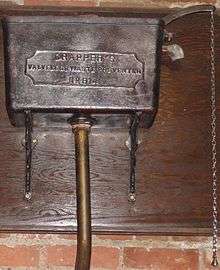Thomas Crapper
| Thomas Crapper | |
|---|---|
 | |
| Baptised |
28 September 1836 Waterside, Thorne, Yorkshire, England |
| Died |
27 January 1910 (aged 73) Anerley, Bromley, England |
| Occupation | Industrialist, plumber |
| Spouse(s) | Maria Green (1837–1902)[1] |
| Parent(s) | Charles Crapper |
Thomas Crapper (baptised 28 September 1836; died 27 January 1910) was a plumber who founded Thomas Crapper & Co in London. He was noted for the quality of his products and received several royal warrants.
Manhole covers with Crapper's company's name on them in Westminster Abbey are now one of London's minor tourist attractions.[2][3] Thomas Crapper & Co owned the world's first bath, toilet and sink showroom, in King's Road until 1966. The firm's lavatorial equipment was manufactured at premises in nearby Marlborough Road (now Draycott Avenue).
Company

Crapper was born in Thorne, Yorkshire, in 1836; the exact date is unknown, but he was baptised on 28 September 1836. His father, Charles, was a sailor. In 1853 he was apprenticed to his brother George, who was a master plumber in Chelsea. After his apprenticeship and three years as a journeyman plumber, in 1861 Crapper set himself up as a sanitary engineer, with his own brass foundry and workshops in nearby Marlborough Road.[1]
The flushing toilet was invented by John Harington in 1596. Joseph Bramah of Yorkshire patented the first practical water closet in England in 1778. George Jennings in 1852 also took out a patent for the flush-out toilet.[4][5] In a time when bathroom fixtures were barely spoken of, Crapper heavily promoted sanitary plumbing and pioneered the concept of the bathroom fittings showroom.

In the 1880s, Prince Edward (later Edward VII) purchased his country seat of Sandringham House in Norfolk and asked Thomas Crapper & Co. to supply the plumbing, including thirty lavatories with cedarwood seats and enclosures, thus giving Crapper his first Royal Warrant. The firm received further warrants from Edward as king and from George V both as Prince of Wales and as king.
In 1904, Crapper retired, passing the firm to his nephew George and his business partner Robert Marr Wharam. Crapper lived at 12 Thornsett Road, Anerley, for the last six years of his life and died on 27 January 1910. He was buried in the nearby Elmers End Cemetery.[1]
In 1966 the company was sold by then owner Robert G. Wharam (son of Robert Marr Wharam) on his retirement, to their rivals John Bolding & Sons. Bolding went into liquidation in 1969. The company fell out of use until it was acquired by Simon Kirby, a historian and collector of antique bathroom fittings, who relaunched the company in Stratford-upon-Avon, producing authentic reproductions of Crapper's original Victorian bathroom fittings.[6]
Siphonic flush toilet

Crapper held nine patents, three of them for water closet improvements such as the floating ballcock, but none was for the flush toilet itself. Thomas Crapper's advertisements implied the siphonic flush was his invention; one having the text "Crapper's Valveless Water Waste Preventer (Patent #4,990) One movable part only", but patent 4990 (for a minor improvement to the water waste preventer) was not his, but that of Albert Giblin in 1898.[7][8] Crapper's nephew, George, did improve the siphon mechanism by which the water flow is started. A patent for this development was awarded in 1897.[9]
Origin of the word "crap"
It has often been claimed in popular culture that the slang term for human bodily waste, crap, originated with Thomas Crapper because of his association with lavatories. A common version of this story is that American servicemen stationed in England during World War I saw his name on cisterns and used it as army slang, i.e. "I'm going to the crapper".[10]
The word crap is actually of Middle English origin and predates its application to bodily waste. Its most likely etymological origin is a combination of two older words, the Dutch krappen: to pluck off, cut off, or separate; and the Old French crappe: siftings, waste or rejected matter (from the medieval Latin crappa, chaff).[10] In English, it was used to refer to chaff, and also to weeds or other rubbish. Its first application to bodily waste, according to the Oxford English Dictionary, appeared in 1846 under a reference to a crapping ken, or a privy, where ken means a house.[10]
References
- 1 2 3 McConnell, Anita (2004), "Crapper, Thomas (1837–1910)", Dictionary of National Biography, Oxford University Press, retrieved 10 November 2008 (subscription or UK public library membership required)
- ↑ Goddard, Donald (26 May 1985), "Group Walks Gain Ground in London", New York Times, retrieved 2 March 2009
- ↑ Thomas Crapper history, Westminster Abbey, Sandringham, Thomas Crapper & Co., 24 January 2004, retrieved 2 February 2009
- ↑ Krinsky, William L. (2 March 1999), "Of Facts and Artifacts", New York Times, retrieved 2 March 2009
- ↑ Wilson, Blake (16 December 2008), "Tom the Plumber", New York Times, retrieved 2 March 2009
- ↑ Hume, Robert (January 2010), "Thomas Crapper: Lavatory Legend", BBC History Magazine, Stone Publishing House 2009, ISBN 978-0-9549909-3-0
- ↑ Hart-Davis, Adam, Thomas Crapper – Fact and Fiction, ExNet, retrieved 13 May 2010
- ↑ GB 189804990, Giblin, Albert, "Improvements in Flushing Cisterns", published 1 March 1898, issued 9 April 1898
- ↑ GB 189700724, Crapper, George & Robert Marr Wharam, "Improvements in or relating to Automatic Syphon Flushing Tanks", published 11 January 1897, issued 6 March 1897
- 1 2 3 World Wide Words
Further reading
- Hart-Davis, Adam (1997). Thunder, Flush and Thomas Crapper: An Encyclopedia. Michael O'Mara Books. ISBN 1-85479-250-4.
- Reyburn, Wallace (2010). Flushed With Pride: The Story of Thomas Crapper. Polperro Heritage Press. ISBN 978-0-9559541-5-3.
External links
| Wikimedia Commons has media related to Thomas Crapper. |
| Look up crap in Wiktionary, the free dictionary. |
- Thomas Crapper at Snopes.com
- Thomas Crapper & Co. Ltd. - the plumbing company founded by Thomas Crapper